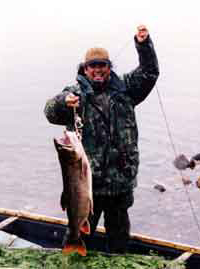Nouns Inflected for Obviation
| ᓂᐙᐱᐦᑖᓐ ᐊᔥᑐᑎᓐ᙮ |  |
niwaapihtaan ashtutin. | I see a hat. |
| ᐙᐱᐦᑎᒻ ᐊᔥᑐᑎᓂᔨᐤ᙮ |  |
waapihtim ashtutiniyiu. | She sees a hat. |
Notice the suffix -iyiu on ᐊᔥᑐᑎᓂᔨᐤ ashtutiniyiu. It is called OBVIATIVE. Obviative inflection happens when there are several third persons in a story. For example, a child and a hat or a frog.
| ᒌ ᐧᐋᐱᒫᐤ ᐄᔨᒃᐦ ᐊᓐ ᐊᐧᐋᔑᔥ᙮ |  |
chii waapimaau iiyikh an awaashish. | This child saw a frog/frogs. |
| ᐧᐋᐱᐦᑎᒻ ᐊᔥᑐᑎᓂᔨᐤ ᐊᓐ ᐊᐧᐋᔑᔥ᙮ |  |
waapihtim ashtutiniyiu an awaashish. | This child sees a hat. |
The form ᐊᐧᐋᔑᔥ awaashish is called PROXIMATE, ᐄᔨᒃᐦ iiyikh and ᐊᔥᑐᑎᓂᔨᐤ ashtutiniyiu are called OBVIATIVE.
For animate nouns, the obviative suffix is -h, like in ᐄᔨᒃᐦ iiyikh above. The number distinction is over-ridden. -h could mean one or many frogs.
For inanimate nouns, the obviative singular has a special suffix -iyiu. The obviative plural looks just like the proximate plural.
Animate Noun
| proximate | obviative | ||||||
| singular | ᐄᔨᒃ |  |
iiyik | ᐄᔨᒃᐦ |  |
iiyikh | frog |
| plural | ᐄᔨᑭᒡ |  |
iiyikich | ᐄᔨᒃᐦ |  |
iiyikh | frogs |
Inanimate Noun
| proximate | obviative | ||||||
| singular | ᐊᔥᑐᑎᓐ |  |
ashtutin | ᐊᔥᑐᑎᓂᔨᐤ |  |
ashtutiniyiu | hat |
| plural | ᐊᔥᑐᑎᓐᐦ |  |
ashtutinh | ᐊᔥᑐᑎᓐᐦ |  |
ashtutinh | hats |
Because of the rule of obviation, a noun possessed by a third person carries the obviative marking.
| ᐅᑖᐱᔥᑳᑭᓐᐦ |  |
utaapishkaakinh | his/her scarf |
| ᐅᓂᒫᓯᒻᐦ |  |
unimaasimh | his/her fish |
Obviation plays an important role in Cree, not just for nouns, and pronouns but also for verbs forms. It allows speakers to rank the importance of participants in a story in ways that are impossible to convey in English. The rule is that you can only have one proximate person or thing at a time in a story, all others must be marked obviative.
The proximate-obviative contrast works like a spotlight on the story participants. The spotlight is the proximate and it can only shine on one person or one group at a time, all the other story participants end up in the obviative. [see story analysis]
This is how the proximate and obviative look in sentences.
| Proximate | Obviative | |||||||
| singular | plural | singular | plural | |||||
| Animate |  |
ᓂᐙᐱᒫᐤ ᐄᔨᒃ᙮ |  |
ᓂᐙᐱᒫᐎᒡ ᐄᔨᑭᒡ᙮ |  |
ᐙᐱᒫᐤ ᐄᔨᒃᐦ᙮ |  |
ᐙᐱᒫᐤ ᐄᔨᒃᐦ᙮ |
| niwaapimaau iiyik. | niwaapimaawich iiyikich. | waapimaau iiyikh. | waapimaau iiyikh. | |||||
| I see a frog. | I see frogs. | She sees a frog. | She sees frogs. | |||||
| Inanimate |  |
ᓂᐙᐱᐦᑖᓐ ᐊᔥᑐᑎᓐ᙮ |  |
ᓂᐙᐱᐦᑖᓐ ᐊᔥᑐᑎᓐᐦ᙮ |  |
ᐙᐱᐦᑎᒻ ᐊᔥᑐᑎᓂᔨᐤ᙮ |  |
ᐙᐱᐦᑎᒻ ᐊᔥᑐᑎᓐᐦ᙮ |
| niwaapihtaan ashtutin. | niwaapihtaan ashtutinh. | waapihtim ashtutiniyiu. | waapihtim ashtutinh. | |||||
| I see a hat. | I see hats. | She sees a hat. | She sees hats. | |||||
 |
Nouns |  |
Top |
 Grammar
Grammar